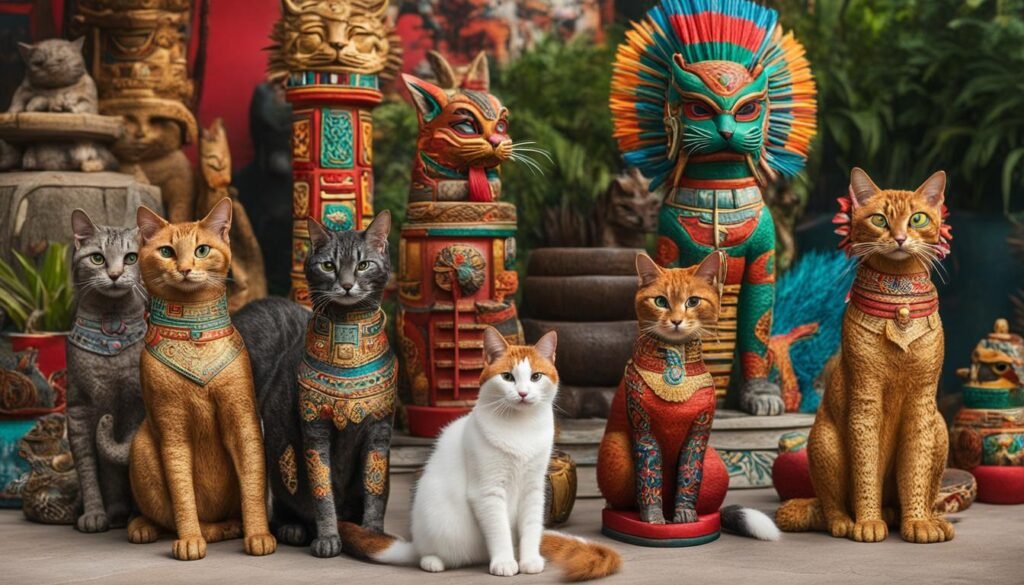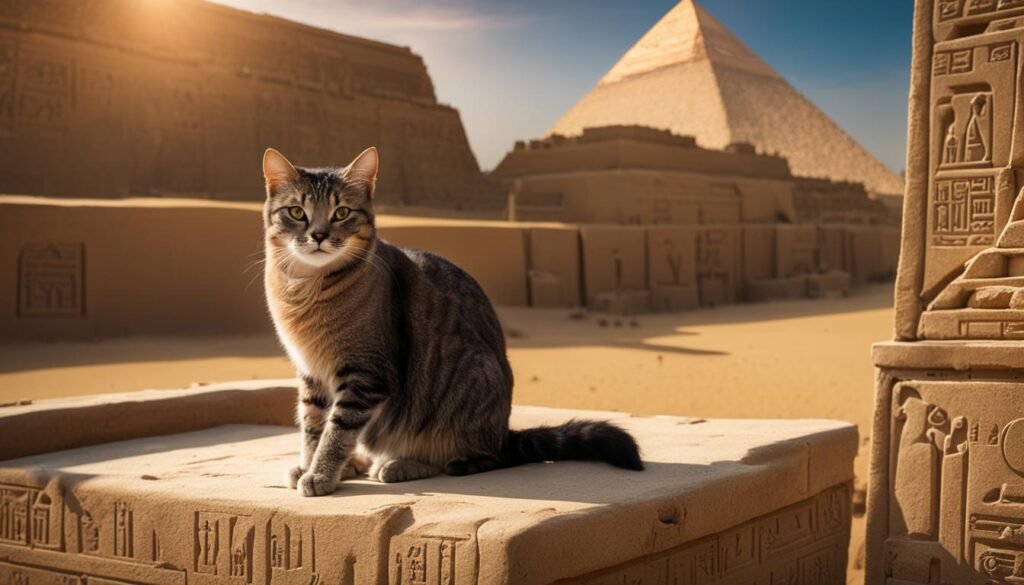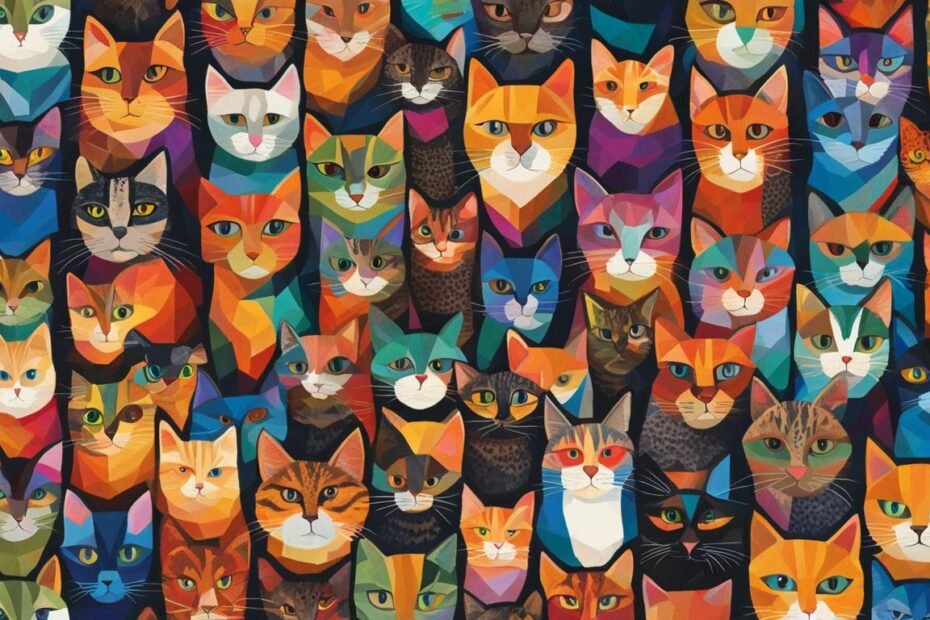Cat culture is a diverse and fascinating aspect of American society. Cats have a rich history, playing significant roles in various historical eras, folklore, and mythology. They have become beloved pets in many households, with a unique and intricate relationship with their human companions. This article will delve into the cultural significance of cats, their presence throughout history, and their place in American society today.
Key Takeaways:
- Cats have a significant cultural significance across different societies.
- In folklore and mythology, cats are often associated with mystery, magic, and wisdom.
- Cats have been present throughout various historical eras, playing different roles and purposes.
- Cat culture in America today is vibrant, encompassing various practices and beliefs.
- Understanding the cultural significance of cats enriches our appreciation for these captivating creatures.
The Cultural Significance of Cats
Cats have held a significant place in cultures across the world. In folklore and mythology, they are often associated with mystery, magic, and wisdom. For example, ancient Egyptians revered cats as sacred creatures, believing they had protective qualities against evil spirits. In Norse mythology, the goddess Freyja is often depicted with a chariot pulled by two large cats. These cultural associations have shaped the perception of cats and their role in society.
Throughout history, cats have captivated human imagination and played prominent roles in various cultural narratives. Their mysterious and independent nature has inspired awe and admiration, leading to their portrayal as symbols of grace, agility, and mysticism. Cats have been the subject of stories, poems, and artwork, capturing the fascination of people throughout the ages.
“The smallest feline is a masterpiece.” – Leonardo da Vinci
The Cultural Significance in Mythology
One of the most enduring mythological associations with cats comes from ancient Egypt. Cats were highly revered and worshipped as the embodiment of the goddess Bastet, who represented fertility, protection, and joy. The ancient Egyptians believed that by honoring and caring for cats, they would receive the blessings of Bastet. This led to the mummification of cats and their burial alongside their human owners.
The symbolism surrounding cats in mythology is not limited to ancient Egypt. In Norse mythology, the goddess Freyja, associated with love, beauty, and fertility, had a special connection with cats. She was often depicted with two large cats, serving as her loyal companions and embodying her divine qualities.
| Mythology | Associated Culture |
|---|---|
| Ancient Egypt | Egyptian |
| Norse | Scandinavian |
These mythological connections reflect the way cats have been integrated into the cultural fabric of different societies, emphasizing their significance and impact on human imagination. Cats continue to hold a special place in contemporary culture, symbolizing independence, mystery, and companionship.

Cats Throughout History
Cats have been an integral part of human history, playing diverse roles in different time periods. From ancient civilizations to modern times, cats have left their mark on society, leaving behind a rich and varied legacy.
Role in Ancient Rome
| Historical Era | Role of Cats |
|---|---|
| Ancient Rome | Cats were valued for their ability to control pests, particularly rats. They provided a vital service in keeping the rodent population in check, thus safeguarding food supplies and public health. |
In ancient Rome, cats were highly esteemed for their efficiency in pest control. They were often employed in granaries and other storage areas to keep rats and mice at bay. Their hunting skills were much appreciated, and their presence was seen as essential in maintaining hygienic conditions and preventing damage to valuable resources.
Symbolism in the Middle Ages
| Historical Era | Role of Cats |
|---|---|
| Middle Ages | Cats were associated with superstitions and often regarded as familiars of witches. However, they also provided practical benefits by protecting food supplies from rodent infestations. |
During the Middle Ages, the perception of cats took a more mystical turn. They were associated with witchcraft and considered the companions of practitioners of the dark arts. Despite this superstition, cats continued to be kept as pets and as means of pest control. Many believed that having cats around would ward off evil spirits and bring good luck.
Modern-Day Companions
| Historical Era | Role of Cats |
|---|---|
| Modern times | Cats have become cherished companions, providing comfort and companionship to individuals and families. They are valued for their affectionate nature and their ability to alleviate stress. |
In contemporary society, cats have become beloved pets, cherished for their companionship and therapeutic benefits. Cats are known for their independence, yet they form deep bonds with their human caretakers. Their presence can bring joy and comfort, and many people consider them as members of their family.
The history of cats reflects their adaptability and significance in various historical eras. From pest controllers in ancient Rome to mystical companions in the Middle Ages, cats have evolved alongside humans, leaving an indelible paw print on our shared story.

Cat Culture in America Today
Cat culture in America is a vibrant and diverse tapestry that reflects the deep connection between cats and humans. From cat shows and competitions to the rise of cat cafes and social media platforms dedicated to our feline friends, there are countless ways in which cat lovers come together to celebrate and share their passion. The cat community in America is a testament to the rich and varied ways in which cats have become an integral part of our society.
Cat Shows and Competitions
One prominent aspect of cat culture in America is the world of cat shows and competitions. These events bring together cat owners and enthusiasts, showcasing various cat breeds, their unique features, and their exceptional abilities. Cat shows provide a platform for breeders and owners to display their cats’ beauty, agility, and temperament, creating a space for appreciation and admiration.
Cat competitions, such as agility trials, where cats navigate obstacle courses, allow these graceful creatures to demonstrate their incredible athleticism and intelligence. These events not only entertain and educate attendees but also foster a sense of community among cat lovers who share a common passion.
Cat Cafes and Social Media
Another significant development in cat culture is the emergence of cat cafes and the power of social media. Cat cafes provide a unique opportunity for people to interact with cats in a relaxed and comfortable environment. These establishments often collaborate with local animal shelters, providing a temporary home for cats and increasing their chances of adoption.
With the advent of social media platforms, cat enthusiasts can now connect and share their love for cats with people from all over the world. Social media accounts dedicated to cats feature adorable photos and videos, spreading joy and bringing together a community of cat lovers. These platforms also serve as a valuable resource for cat owners, offering advice and support on topics ranging from cat care to behavioral issues.
| Cat Culture in America Today | Key Highlights |
|---|---|
| Cat Shows and Competitions | Showcasing various cat breeds, their unique features, and exceptional abilities |
| Cat Cafes and Social Media | Providing opportunities for people to interact with cats and connecting cat lovers worldwide |
In conclusion, cat culture in America encompasses a wide range of practices and beliefs. From the excitement of cat shows and competitions to the cozy and welcoming atmosphere of cat cafes, there are countless ways for cat lovers to celebrate their feline companions. The power of social media has also played a significant role in connecting cat enthusiasts and fostering a sense of community. Cat culture in America continues to evolve and grow, reflecting the diverse and enduring bond between humans and cats.
Conclusion
The exploration of cat culture diversity across America reveals the deep-rooted cultural significance of cats in human society. From their roles in folklore and mythology to their place in everyday life, cats hold a special place in our hearts and homes.
Throughout history, cats have been associated with mystery, magic, and wisdom, leaving an indelible mark on cultures around the world. Ancient Egyptians revered cats as sacred creatures, while Norse mythology depicted goddesses with chariots driven by mighty felines. These cultural associations have shaped how cats are perceived and celebrated in different societies.
From ancient times to the present day, cats have held various roles in society. They were valued for their pest control abilities in ancient Rome, and in the Middle Ages, they were both feared as familiars of witches and appreciated for their practical use in keeping rodents away. Today, cats have become cherished companions, providing comfort and companionship to individuals and families across America.
As cat culture continues to evolve, we see a diverse range of practices and beliefs. From cat shows and competitions showcasing various breeds to the growing popularity of cat cafes, the love for feline friends is celebrated in many ways. Social media platforms have also played a significant role in connecting cat enthusiasts, allowing them to share their passion and stories with others.
The cultural significance of cats, their rich history in folklore and mythology, and their place in American society today are a testament to the enduring bond between cats and humans. Understanding and appreciating the diverse aspects of cat culture diversity adds depth to our appreciation for these beloved creatures.
FAQ
What is the cultural significance of cats?
Cats have been associated with mystery, magic, and wisdom in folklore and mythology. They have been revered as sacred creatures in ancient Egyptian culture and have played a role in various mythological stories. Cats symbolize protection, intelligence, and independence in many cultures.
How have cats been present throughout history?
Cats have had different roles depending on the historical era. In ancient Rome, they were valued for their ability to control pests. During the Middle Ages, they were associated with superstition and believed to be familiars of witches. In more recent history, cats have become cherished companions providing comfort and companionship.
What is cat culture like in America today?
Cat culture in America is diverse and vibrant. There are cat shows and competitions showcasing various breeds. Cat cafes have also become popular, allowing people to interact with cats while enjoying a cup of coffee. Social media platforms have connected cat enthusiasts, creating a community centered around cats.
Why are cats so beloved as pets in American society?
Cats provide comfort, companionship, and entertainment to individuals and families. Their independent nature and ability to adapt to various living situations make them popular pets. Additionally, cats are known for their unique personalities and ability to form deep bonds with their human companions.
How does understanding cat culture diversity enrich our appreciation for cats?
Understanding the cultural significance of cats and their diverse history deepens our appreciation for these mysterious and captivating creatures. It allows us to see the enduring bond between cats and humans and recognize the special place they hold in our hearts and homes.
